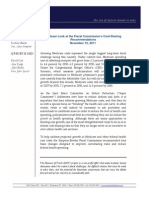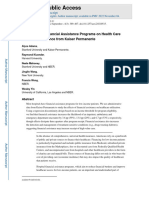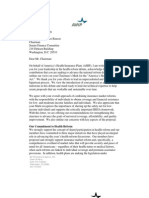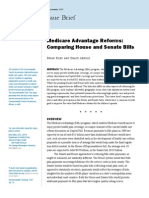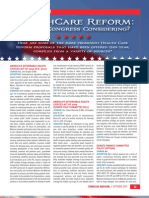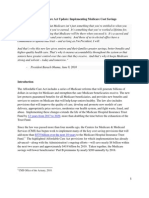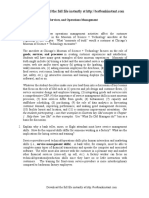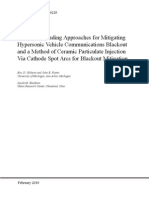MMMM
MMMM
Uploaded by
Maria Galla'Copyright:
Available Formats
MMMM
MMMM
Uploaded by
Maria Galla'Original Title
Copyright
Available Formats
Share this document
Did you find this document useful?
Is this content inappropriate?
Copyright:
Available Formats
MMMM
MMMM
Uploaded by
Maria Galla'Copyright:
Available Formats
Annals of Internal Medicine IDEAS AND OPINIONS
Single-Payer Reform: The Only Way to Fulfill the President's Pledge of
More Coverage, Better Benefits, and Lower Costs
Steffie Woolhandler, MD, MPH, and David U. Himmelstein, MD
P resident Donald Trump and congressional Republi-
cans have vowed to repeal and replace the Patient
Protection and Affordable Care Act (ACA). Repealing it
12.4% versus 2.2% in traditional Medicare (2). Reducing
overhead to Medicare's level would save approxi-
mately $220 billion this year (Table) (3). Single-payer
is relatively easy. Replacing it with “something great” is reform could also sharply reduce billing and paperwork
much trickier. The president has promised universal costs for physicians, hospitals, and other providers. For
coverage and reduced deductibles and copayments, example, by paying hospitals lump-sum operating bud-
all within tight budgetary constraints. That is a tall order gets rather than forcing them to bill per patient, Scot-
and unlikely to be filled by proposals that Republicans land and Canada have held hospital administrative
have offered thus far. costs to approximately 12% of their revenue versus
Speaker of the House Paul Ryan's blueprint (1) 25.3% in the United States (4). Simplified, uniform bill-
would rebrand the ACA's premium subsidies as “tax ing procedures could reduce the money and time that
credits” (technically, the subsidies are already tax physicians spend on billing-related documentation.
credits) and offer them to anyone lacking job-based All told, we estimate that single-payer reform could
coverage— even the wealthy—reducing the funds avail- save approximately $504 billion annually on bureau-
able to subsidize premiums for lower-income persons cracy (Table). Any such estimate is imprecise; however,
in the United States. He would allow “mini-med” plans this figure is in line with Pozen and Cutler's estimate
offering miniscule coverage and interstate sales of in- ($383 billion, updated to reflect health care inflation)
surance, circumventing state-based consumer protec- (5), which excludes potential savings for providers
tions. And he would augment tax breaks for health sav- other than physicians and hospitals. Additional savings
ings accounts, a boon for persons in high tax brackets. could come from adopting the negotiating strategies
Speaker Ryan would also end the long-standing that most nations with national health insurance use,
federal commitment to match states' Medicaid spend- which pay approximately one half what we do for pre-
ing, substituting block grants that state governments scription drugs.
could divert to nonmedical purposes. Moreover, de- Of course, single-payer reform would bring added
coupling federal contributions from actual medical ex- costs as well as savings. Full coverage would (and
penditures amounts to a sotto voce cut. For Medicare, should) boost use for the 26 million persons in the
he would trim federal spending by delaying eligibility United States who remain uninsured despite the ACA.
until age 67 years; replace seniors' guaranteed benefits And plugging the gaps in existing coverage (abolishing
with vouchers to purchase coverage; and tie the vouch- copayments and deductibles, covering such services as
ers' value to overall inflation, which lags behind health dental and long-term care that many policies exclude,
care inflation. and bringing Medicaid fees up to par) would further
In sum, Speaker Ryan's proposal, and a similar one increase clinical expenditures.
from Secretary of Health and Human Services Tom Studies provide imperfect guidance on the proba-
Price, would shrink the coverage of poor and low- ble magnitude of changes in use under single-payer
income persons in the United States while maintaining reform. Microlevel experiments indicate that when a
(or expanding) outlays for some higher-income groups. few persons in a community gain full coverage, their
That approach might save federal dollars by shifting use surges (6). But when many persons gain coverage,
costs onto patients and state budgets. But containing the fixed supply of physicians and hospitals constrains
overall health care costs requires denting the revenues community-wide increases in use. For example, when
(and profits) of corporate giants that increasingly dom- Canada rolled out its single-payer program, the total
inate care—an unlikely outcome of policies that expand number of physician visits changed little; increased vis-
the role of private insurers and weaken public oversight. its for poorer, sicker patients were offset by small de-
Although Republicans' proposals seem unlikely to clines in visits for healthier, more affluent persons (7).
achieve President Trump's triple aim (more coverage, Despite dire predictions of patient pileups, Medicare
better benefits, and lower costs), single-payer reform and Medicaid's start-up in 1966 similarly shifted care
could. Such reform would replace the current welter of toward the poor but caused no net increase in use (8).
insurance plans with a single, public plan covering ev- Despite some uncertainties, analysts from govern-
eryone for all medically necessary care—in essence, an ment agencies and prominent consulting firms have
expanded and upgraded version of the traditional concluded that administrative and drug savings would
Medicare program (that is, not Medicare Advantage). fully offset increased use, allowing universal, compre-
The economic case for single-payer reform is com- hensive coverage within the current health care
pelling. Private insurers' overhead currently averages budgetary envelope (9). International experience with
This article was published at Annals.org on 21 February 2017.
Annals.org Annals of Internal Medicine 1
Downloaded From: http://annals.org/pdfaccess.ashx?url=/data/journals/aim/0/ by a NYU Medical Center Library User on 02/20/2017
IDEAS AND OPINIONS Single-Payer Reform
Table. Estimated Administrative and Prescription Drug Savings Under Single-Payer Reform, 2017
Sector 2017 Spending Savings With Savings Available to Expand and
Without Reform, Single-Payer Improve Coverage Under Single-
$ (billion) Reform, % Payer Reform, 2017, $ (billion)
Insurance overhead and administration of public programs 323.3* 68.0 220.0†
Hospital administration and billing‡ 283.9 52.6 149.3
Physicians' office administration and billing§ 187.6 40.1 75.3
Total administration§ 1091.7 46.1 503.6
Outpatient prescription drugs 362.7* 31.2兩兩 113.2
Total administration plus outpatient prescription drugs – – 616.8
* From National Health Expenditure Amounts by Type of Expenditure and Source of Funds: Calendar Years 1960 –2025 in projections format
(www.cms.gov/Research-Statistics-Data-and-Systems/Statistics-Trends-and-Reports/NationalHealthExpendData/Downloads/NHE60-25.zip).
† Based on the assumption that insurance overhead would decrease to 2.2% (overhead in traditional Medicare program according to the 2016
Medicare Trustees' report) and that the share of expenditures covered by insurance would increase from the current value of 74% to 80%.
‡ Based on data from reference 4 applied to the national health expenditure accounts estimate of 2017 hospital spending.
§ Based on data from reference 3 applied to 2017 national health expenditure estimates. Total administration estimates include additional admin-
istrative savings for nursing homes, home care agencies, nonphysician practitioners, and employers.
兩兩 Assumes no savings for Medicaid, U.S. Department of Veterans Affairs, and other federal government programs that already receive discounts;
50% savings on brand-name drugs; and no savings on generics, which account for approximately 28% of prescription drug spending.
single-payer reform provides further reassurance. It has Requests for Single Reprints: Steffie Woolhandler, MD, MPH,
been thoroughly vetted in Canada and other nations 255 West 90th Street, New York, NY 10024; e-mail,
where access is better, costs are lower, and quality is swoolhan@hunter.cuny.edu.
similar to that in the United States.
Current author addresses and author contributions are avail-
The potential health benefits from single-payer re-
able at Annals.org.
form are more important than the economic ones. Be-
ing uninsured has mortal consequences. Covering the Ann Intern Med. doi:10.7326/M17-0302
26 million persons in the United States who are cur-
rently uninsured would probably save tens of thou-
sands of lives annually. And underinsurance now en- References
dangers many more by, for example, delaying persons 1. A Better Way. A better way: our vision for a confident America. 22
from seeking care for myocardial infarction or causing June 2016. Accessed at https://abetterway.speaker.gov/_assets/pdf
patients to skimp on cardiac or asthma medications. /ABetterWay-HealthCare-PolicyPaper.pdf on 1 February 2017.
Single-payer reform would also free patients from the 2. The Boards of Trustees, Federal Hospital Insurance and Federal
confines of narrow provider networks and lift the finan- Supplementary Medical Insurance Trust Funds. 2016 annual report
cial threat of illness, a frequent contributor to bank- of the Boards of Trustees, Federal Hospital Insurance and Federal
Supplementary Medical Insurance Trust Funds. 22 June 2016.
ruptcy and the most common cause of serious credit Accessed at www.cms.gov/Research-Statistics-Data-and-Systems
problems. /Statistics-Trends-and-Reports/ReportsTrustFunds/Downloads
The ACA has helped millions. However, our health /TR2016.pdf on 2 February 2017.
care system remains deeply flawed. Nine percent of 3. Woolhandler S, Campbell T, Himmelstein DU. Costs of health care
persons in the United States are uninsured, deductibles administration in the United States and Canada. N Engl J Med. 2003;
are rising and networks narrowing, costs are again on 349:768-75. [PMID: 12930930]
the upswing, the pursuit of profit too often displaces 4. Himmelstein DU, Jun M, Busse R, Chevreul K, Geissler A, Jeuris-
sen P, et al. A comparison of hospital administrative costs in eight
medical goals, and physicians are increasingly demor-
nations: US costs exceed all others by far. Health Aff (Millwood).
alized. Reforms that move forward from the ACA are 2014;33:1586-94. [PMID: 25201663] doi:10.1377/hlthaff.2013.1327
urgently needed and widely supported. Even two fifths 5. Pozen A, Cutler DM. Medical spending differences in the United
of Republicans (and 53% of those favoring repeal of the States and Canada: the role of prices, procedures, and administra-
ACA) would opt for single-payer reform (10). Yet, the tive expenses. Inquiry. 2010;47:124-34. [PMID: 20812461]
current Washington regime seems intent on moving 6. Baicker K, Taubman SL, Allen HL, Bernstein M, Gruber JH,
backward, threatening to replace the ACA with some- Newhouse JP, et al; Oregon Health Study Group. The Oregon
thing far worse. experiment— effects of Medicaid on clinical outcomes. N Engl J Med.
2013;368:1713-22. [PMID: 23635051] doi:10.1056/NEJMsa1212321
From The City University of New York at Hunter College, New 7. Enterline PE, Salter V, McDonald AD, McDonald JC. The distribu-
York, New York. tion of medical services before and after “free” medical care—the
Quebec experience. N Engl J Med. 1973;289:1174-8. [PMID: 475
Disclaimer: Drs. Woolhandler and Himmelstein served as un- 4965]
paid advisors to Senator Bernie Sanders' presidential cam- 8. Wilder CS. Volume of physician visits. United States—July 1966-
June 1967. Vital Health Stat 10. 1968;10:1-60. [PMID: 5303847]
paign. They cofounded and remain active in Physicians for a
9. Physicians for a National Health Program. How much would a
National Health Program, an organization that advocates for single payer cost? A summary of studies compiled by Ida Hellander,
single-payer national health insurance. They have received no MD. 2016. Accessed at www.pnhp.org/facts/single-payer-system
financial compensation from that organization and have no -cost on 2 February 2017.
financial conflicts of interest regarding this commentary. 10. Newport F. Majority in U.S. support idea of fed-funded health-
care system. Gallup. 16 May 2016. Accessed at www.gallup.com/poll
Disclosures: Disclosures can be viewed at www.acponline.org /191504/majority-support-idea-fed-funded-healthcare-system.aspx
/authors/icmje/ConflictOfInterestForms.do?msNum=M17-0302. on 2 February 2017.
2 Annals of Internal Medicine Annals.org
Downloaded From: http://annals.org/pdfaccess.ashx?url=/data/journals/aim/0/ by a NYU Medical Center Library User on 02/20/2017
Current Author Addresses: Drs. Woolhandler and Himmel- Author Contributions: Analysis and interpretation of the data:
stein: 255 West 90th Street, New York, NY 10024. S. Woolhandler, D.U. Himmelstein.
Drafting of the article: S. Woolhandler, D.U. Himmelstein.
Final approval of the article: S. Woolhandler, D.U.
Himmelstein.
Collection and assembly of data: S. Woolhandler, D.U.
Himmelstein.
Annals.org Annals of Internal Medicine
Downloaded From: http://annals.org/pdfaccess.ashx?url=/data/journals/aim/0/ by a NYU Medical Center Library User on 02/20/2017
You might also like
- Evan Moor BooksDocument2 pagesEvan Moor Booksravibhargavaraam20% (5)
- Fulton Superior Court Disqualifies District Attorney Fani WillisDocument8 pagesFulton Superior Court Disqualifies District Attorney Fani WillisLindsey BasyeNo ratings yet
- NSG 436 Analysis of A UDocument6 pagesNSG 436 Analysis of A Uapi-521018364100% (1)
- Medicare Prescription Drugs: Medical Necessity Meets Fiscal Insanity Cato Briefing Paper No. 91Document12 pagesMedicare Prescription Drugs: Medical Necessity Meets Fiscal Insanity Cato Briefing Paper No. 91Cato InstituteNo ratings yet
- The Costs of Regulation and Centralization in Health Care by Scott AtlasDocument22 pagesThe Costs of Regulation and Centralization in Health Care by Scott AtlasHoover InstitutionNo ratings yet
- Cost Sharing MotDocument9 pagesCost Sharing MotCommittee For a Responsible Federal BudgetNo ratings yet
- The Establishment Strikes Back: Medical Savings Accounts and Adverse Selection, Cato Briefing PaperDocument7 pagesThe Establishment Strikes Back: Medical Savings Accounts and Adverse Selection, Cato Briefing PaperCato InstituteNo ratings yet
- Literature Review APADocument7 pagesLiterature Review APAStephan ChiariniNo ratings yet
- Premium Support in MedicareDocument4 pagesPremium Support in MedicareAi NurcahyaniNo ratings yet
- Garson 2000Document3 pagesGarson 2000carlosmedjimNo ratings yet
- Nik Pay Pung Archer Frak T 2020Document16 pagesNik Pay Pung Archer Frak T 2020PsydocNo ratings yet
- Affordable Care Act - EditedDocument8 pagesAffordable Care Act - Editedjw3990725No ratings yet
- Economics Assignement Week 7Document5 pagesEconomics Assignement Week 7Grace FranzNo ratings yet
- Perspective: New England Journal MedicineDocument3 pagesPerspective: New England Journal MedicineAllen ZhuNo ratings yet
- Ib 33 PDFDocument12 pagesIb 33 PDFLatinos Ready To VoteNo ratings yet
- Community Catalyst 2/25/11 Letter To HHS Secretary With Medicaid Cost-Savings SuggestionsDocument7 pagesCommunity Catalyst 2/25/11 Letter To HHS Secretary With Medicaid Cost-Savings SuggestionsSandy CohenNo ratings yet
- Benefits of Implementing A Universal Healthcare System in The UsDocument6 pagesBenefits of Implementing A Universal Healthcare System in The UsWazo TankNo ratings yet
- CBO Deficit Reduction Analysis - Health Care Spending OptionsDocument39 pagesCBO Deficit Reduction Analysis - Health Care Spending OptionsKFFHealthNewsNo ratings yet
- Prepplan PDFDocument12 pagesPrepplan PDFCommittee For a Responsible Federal BudgetNo ratings yet
- The Impact of Financial Assistance Programs On Health Care Utilization - Evidence From Kaiser PermanenteDocument20 pagesThe Impact of Financial Assistance Programs On Health Care Utilization - Evidence From Kaiser PermanenteSayonaraNo ratings yet
- Improving The Prognosis of Healthcare in The United StatesDocument22 pagesImproving The Prognosis of Healthcare in The United StatesBen CollNo ratings yet
- Medicaid Per Capita Cap Would Shift Costs To States and Place Low-Income Beneficiaries at RiskDocument13 pagesMedicaid Per Capita Cap Would Shift Costs To States and Place Low-Income Beneficiaries at RiskJamie SandersonNo ratings yet
- National Factsheet Final 073109Document2 pagesNational Factsheet Final 073109sech100% (2)
- Policy Focus: Why 'Medicare For All' Is The Wrong SolutionDocument7 pagesPolicy Focus: Why 'Medicare For All' Is The Wrong SolutionIndependent Women's ForumNo ratings yet
- Principle #5: Continued Vigilance in Health Reform March 31, 2010Document6 pagesPrinciple #5: Continued Vigilance in Health Reform March 31, 2010Committee For a Responsible Federal BudgetNo ratings yet
- Toward An Integrated Federal Health SystemDocument2 pagesToward An Integrated Federal Health SystemyaivaziNo ratings yet
- Thomas Lazarte Paper 1Document8 pagesThomas Lazarte Paper 1api-355446351No ratings yet
- The Fiscal Challenges Facing Medicare: Entitlement Spending and MedicareDocument20 pagesThe Fiscal Challenges Facing Medicare: Entitlement Spending and MedicarelosangelesNo ratings yet
- The Senior Protection PlanDocument51 pagesThe Senior Protection PlanCenter for American ProgressNo ratings yet
- Managed CareDocument4 pagesManaged CareMiguel CompletoNo ratings yet
- High Deductible Health PlansDocument6 pagesHigh Deductible Health PlansiggybauNo ratings yet
- 1NC - M4A - MetrosDocument59 pages1NC - M4A - Metrosanikethg2009No ratings yet
- CBO Background On Medical MalpracticeDocument80 pagesCBO Background On Medical MalpracticeRamana GorrepatiNo ratings yet
- The Next Steps For Medicare Reform, Cato Policy AnalysisDocument24 pagesThe Next Steps For Medicare Reform, Cato Policy AnalysisCato InstituteNo ratings yet
- Policy BriefDocument9 pagesPolicy BriefvnkrnjNo ratings yet
- Massachusetts' Plan: A Failed Model For Health Care Reform: February 18, 2009Document19 pagesMassachusetts' Plan: A Failed Model For Health Care Reform: February 18, 2009raj2closeNo ratings yet
- Fact Sheet - Health Care - FINALDocument6 pagesFact Sheet - Health Care - FINALsarahkliffNo ratings yet
- Paper Cuts: Reducing Health Care Administrative CostsDocument48 pagesPaper Cuts: Reducing Health Care Administrative CostsCenter for American ProgressNo ratings yet
- September 21, 2009 The Honorable Max Baucus Chairman Senate FinanceDocument13 pagesSeptember 21, 2009 The Honorable Max Baucus Chairman Senate Financeapi-26254299No ratings yet
- Impact of Societal Trends: Agagon, Julie Ann G. Pharm Ad 2Document5 pagesImpact of Societal Trends: Agagon, Julie Ann G. Pharm Ad 2Glyness LiyangnaNo ratings yet
- America Healthcare DeliveryDocument8 pagesAmerica Healthcare DeliveryfanuelybetNo ratings yet
- The Math of AcosDocument14 pagesThe Math of AcosnishpaNo ratings yet
- Commonwealth Fund Biles Medicare Issue Brief 1221Document12 pagesCommonwealth Fund Biles Medicare Issue Brief 1221nchc-scribdNo ratings yet
- Obamacare IMPACT On MAINEDocument13 pagesObamacare IMPACT On MAINELevitatorNo ratings yet
- Navigating New Challenges in Medicare RX Drug BillingDocument1 pageNavigating New Challenges in Medicare RX Drug BillingVarinder KaurNo ratings yet
- What Is Congress Considering?Document3 pagesWhat Is Congress Considering?brendawilliamsNo ratings yet
- Mac Guineas Testimony Medicare Reform 12oct11Document12 pagesMac Guineas Testimony Medicare Reform 12oct11Committee For a Responsible Federal BudgetNo ratings yet
- SPR BHB Funding Fact Sheet May 2019Document5 pagesSPR BHB Funding Fact Sheet May 2019BernewsAdminNo ratings yet
- Value-Based Insurance Design Landscape DigestDocument35 pagesValue-Based Insurance Design Landscape DigestNational Pharmaceutical CouncilNo ratings yet
- Running Head: Highs Deductible Healthcare Spending Accounts (Hsas)Document15 pagesRunning Head: Highs Deductible Healthcare Spending Accounts (Hsas)Topher MatthewsNo ratings yet
- Health Care Regulation: A $169 Billion Hidden Tax Cato Policy Analysis No. 527Document32 pagesHealth Care Regulation: A $169 Billion Hidden Tax Cato Policy Analysis No. 527Cato Institute100% (3)
- Reforming Health Care in AmericaDocument2 pagesReforming Health Care in Americalbrecht100% (1)
- The Situation: President-Elect Obama Henry J. Aaron, The Brookings Institution January 16, 2009 Reform Health CareDocument3 pagesThe Situation: President-Elect Obama Henry J. Aaron, The Brookings Institution January 16, 2009 Reform Health CareHim LokNo ratings yet
- Business ManagementDocument7 pagesBusiness ManagementMbugua Wa IrunguNo ratings yet
- Consumer Driven Health CareDocument9 pagesConsumer Driven Health CareKevin VarnerNo ratings yet
- Advantages and Disadvantages of ObamacareDocument20 pagesAdvantages and Disadvantages of ObamacareAlexander IvanoffNo ratings yet
- Cooper Et Al., 2022 Geographical Variation in Health Spending Across The US Among Privately InsuredDocument11 pagesCooper Et Al., 2022 Geographical Variation in Health Spending Across The US Among Privately InsuredDayn KirkseyNo ratings yet
- Medicare Is Not BankruptDocument3 pagesMedicare Is Not BankruptMustaffah KabelyyonNo ratings yet
- The HMO Act of 1973 Health Maintenance Organization Act of 1973Document3 pagesThe HMO Act of 1973 Health Maintenance Organization Act of 1973Sai PrabhuNo ratings yet
- Running Head: Benchmark-Analysis of U.S. Health Care Policy 1Document7 pagesRunning Head: Benchmark-Analysis of U.S. Health Care Policy 1api-520843051No ratings yet
- ACA Update - Implementing Medicare Costs SavingsDocument11 pagesACA Update - Implementing Medicare Costs SavingsRich ElmoreNo ratings yet
- Mining for Gold In a Barren Land: Pioneer Accountable Care Organization Potential to Redesign the Healthcare Business Model in a Post-Acute SettingFrom EverandMining for Gold In a Barren Land: Pioneer Accountable Care Organization Potential to Redesign the Healthcare Business Model in a Post-Acute SettingNo ratings yet
- Change XP Boot ScreenDocument5 pagesChange XP Boot ScreenJohn AnandNo ratings yet
- Solution Manual For OM 4 4th Edition by CollierDocument15 pagesSolution Manual For OM 4 4th Edition by CollierNonoyArendainNo ratings yet
- Crim221 SalemDocument75 pagesCrim221 SalemRonald Borgy MarcosNo ratings yet
- Affidavit of Arresting OfficersDocument2 pagesAffidavit of Arresting OfficersNicko AngeloNo ratings yet
- History SbaDocument4 pagesHistory SbaDanielleNo ratings yet
- Cash Book Past PapersDocument11 pagesCash Book Past Papersanmitchell586No ratings yet
- Transportation - Sedan Chairs & Rolling ChairsDocument54 pagesTransportation - Sedan Chairs & Rolling ChairsThe 18th Century Material Culture Resource Center100% (5)
- Madoff Securities: Sequence of EventsDocument7 pagesMadoff Securities: Sequence of EventsMicka EllahNo ratings yet
- PMI-ACP Mock ExamDocument7 pagesPMI-ACP Mock ExammaviarenaNo ratings yet
- Day One Containers Kubernetes ContrailDocument283 pagesDay One Containers Kubernetes ContraildildakoNo ratings yet
- Sy, Ahcy Mari P. BSA 1-12 Vlog ReviewDocument5 pagesSy, Ahcy Mari P. BSA 1-12 Vlog ReviewAhcy SongNo ratings yet
- Topic: Conclusion::Worksheet Number:36Document3 pagesTopic: Conclusion::Worksheet Number:36hardik321No ratings yet
- GRID CTS Implementation Northern GridDocument22 pagesGRID CTS Implementation Northern GridRHS ProductionNo ratings yet
- Cost Estimating Approach Chapter ThreeDocument36 pagesCost Estimating Approach Chapter ThreeTewodros Tadesse100% (1)
- Gunning 1969Document11 pagesGunning 1969valentina raniNo ratings yet
- Times Leader 09-24-2013Document32 pagesTimes Leader 09-24-2013The Times LeaderNo ratings yet
- Prescriptive PeriodDocument2 pagesPrescriptive PeriodBey Villanueva100% (1)
- Undergrad Sept24 MemoDocument3 pagesUndergrad Sept24 Memoapus05460No ratings yet
- Class 6 Geo CH 2 Extra QuestionsDocument10 pagesClass 6 Geo CH 2 Extra QuestionsDiya JainNo ratings yet
- Effect of T6 Heat Treatment Parameters On TechnoloDocument6 pagesEffect of T6 Heat Treatment Parameters On Technoloferhat aydoganNo ratings yet
- LVVTA STD Suspension SystemsDocument24 pagesLVVTA STD Suspension Systemsadave1No ratings yet
- Sardar Patel Pic To 00 Man JDocument104 pagesSardar Patel Pic To 00 Man JchitraNo ratings yet
- Instructional StrategiesDocument2 pagesInstructional Strategiesmichelleangel14No ratings yet
- Physics - Electromagnetic WaveDocument10 pagesPhysics - Electromagnetic WaveEuw Chaiwanont100% (1)
- Abnormal Psychology - ParaphiliaDocument16 pagesAbnormal Psychology - ParaphiliaHara U. OndiNo ratings yet
- Deel Optiplex 780 Service Manual PDFDocument80 pagesDeel Optiplex 780 Service Manual PDFmohamed elfnanNo ratings yet
- 2 Pandurang - Tukia - and - Bhillia - Vs - The - State - of - Hyderas540048COM512092Document9 pages2 Pandurang - Tukia - and - Bhillia - Vs - The - State - of - Hyderas540048COM512092Tanvi MehtaNo ratings yet
- Re Entry Avinoincs - 2Document25 pagesRe Entry Avinoincs - 2Deewakar SharmaNo ratings yet





